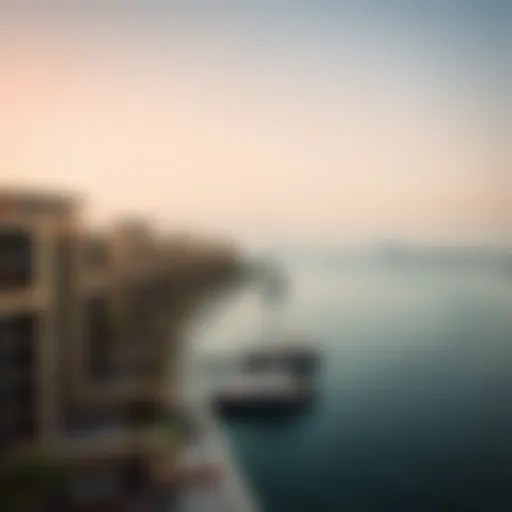Comprehensive Guide to Dubai RTA Ferry Timings


Intro
Navigating the waterways of Dubai is more than just a scenic adventure; it's a vital component of the city’s transport infrastructure. The Dubai Road and Transport Authority (RTA) operates a ferry service that offers both commuters and tourists an enjoyable means to traverse the city’s extensive water routes. In this article, we’ll explore everything you need to know about the RTA ferry timings, routes, ticket pricing, and operational details to help you make the most of your journeys across the stunning Dubai Marina and beyond.
Dubai's ferry system is a blend of leisure and utility. For residents, it’s often a preferred mode of transportation that sidesteps the hustle and bustle of city traffic. For visitors, it presents an alternative way to witness the shimmering skyline from the water. Regardless of the purpose of your travel, understanding the ferry schedule is crucial.
From the early morning rush hour services to those late-night rides, knowing when ferries sail can mean the difference between a swift commute and waiting in vain.
This article aims to empower you with key insights into:
- The operational hours of the ferry service
- The different routes available for travelers
- Ticket pricing details
- Accessibility options for all passengers
So, whether you’re an avid commuter or a curious traveler, keep reading! Understanding these aspects will enhance your overall experience in Dubai's enchanting aquatic environment.
Prolusion to Dubai's RTA Ferry System
Dubai's RTA ferry system, an integral part of the city's transport landscape, serves not only as a means of moving from one point to another but also as a vital connection to the diverse activities and attractions that line its stunning coastlines. The ferries, operated by the Roads and Transport Authority (RTA), offer a blend of practicality and leisure that few other transport modes provide.
As Dubai continues to grow and develop at a breakneck pace, the importance of an efficient and scenic transport system has never been more evident. The RTA ferries allow locals and tourists alike to navigate the waterways in style, bypassing traffic congestion that often plagues the city’s streets.
Historical Context
The historical roots of the RTA ferry system lie in the traditional ways people traversed Dubai's waterways, using small wooden boats known as ‘abras’. These humble vessels have transformed over the years, evolving from basic transport options to modern ferries equipped with amenities and services that cater to today’s commuter needs. Since their inception, these ferries have played a pivotal role in enhancing connectivity and encouraging tourism. The commitment to develop and maintain such a service reflects Dubai’s vision for integrated transport systems. In a city that thrives on innovation and tourism, the ferry system showcases part of its rich cultural heritage while embracing modern transportation standards.
Current Relevance
In today's context, the RTA ferry system is quite relevant, addressing both daily commuting needs and leisure travels. With the bustling growth of the city's waterfront areas, the ferries have become a popular transport option. They cater not just to daily commuters traveling between key business districts, but also to tourists looking to enjoy a unique view of the city from the water. Each route provides passengers access to major attractions, including shopping destinations, dining experiences, and cultural landmarks, all while allowing travelers to experience the serenity of Dubai's waterways.
The efficiency of ferry services also plays into larger discussions about urban mobility and sustainability. By emphasizing the use of waterways for transportation, Dubai is not only easing congestion on its roads but also promoting more environmentally friendly transport options. This aligns well with global trends toward more sustainable living and urban planning practices.
In summary, understanding the RTA ferry system is essential for anyone interested in maximizing their experience in Dubai. It bridges the gap between historical significance and modern relevance, all while enhancing the beauty of life in this vibrant city.
Types of Ferries Operated by RTA
The types of ferries operated by the Roads and Transport Authority (RTA) of Dubai play a crucial role in enhancing the public transportation landscape in the city. Each ferry service meets specific needs of residents, commuters, and tourists who desire to navigate the waterways of Dubai efficiently. Understanding the different types of ferries available is a key element for anyone looking to tailor their travel plans to make the best use of these services. Below, we delve into three main types of ferries: the Waterbus, Abra, and Water Taxi, explaining their unique characteristics, benefits, and considerations for usage.
Waterbus
The Waterbus is a modern and versatile option for commuting in Dubai's bustling urban hubs. This service operates along several routes, connecting critical points, such as shopping malls, offices, and residential areas. The spacious design of the Waterbus allows for a comfortable ride, capable of accommodating more passengers at once, all while ensuring that the ride offers great views of the iconic skyline.
- Key Features of the Waterbus:
- Capacity: Holds up to 30 passengers at a time.
- Comfort: Equipped with air conditioning for a pleasant journey, especially important during the sweltering summer months.
- Routes: Connects main spots like Dubai Marina and the Dubai Mall area.
Using the Waterbus not only saves time but also allows for a unique perspective of the city's beautiful landmarks. It’s favored by both locals and visitors, enabling an unforgettable travel experience over the waters.
Abra
The Abra is perhaps the most traditional and charming mode of ferry transport in Dubai. These wooden boats are a symbol of the city's maritime heritage, offering quick and direct routes across the Dubai Creek. Each Abra ride costs a nominal fee, making it an economical choice for many.
- Characteristics of the Abra:
- Capacity: Typically holds around 20 passengers.
- Experience: Each ride is a nostalgic journey, encapsulating the essence of Dubai's past as a trading port.
- Accessibility: Operates on a continuous basis, making it highly convenient especially for crossings between Bur Dubai and Deira.
The Abra is not just a form of transport; it serves as a cultural experience, allowing riders to appreciate the city's rich history while crossing the creek. It’s especially popular for tourists who want a slice of local life.
Water Taxi
Water Taxis offer a more personalized ferry experience when compared to the Waterbus and Abra. They are perfect for passengers looking for a combination of luxury and convenience. With one-on-one service, the Water Taxi allows travelers to set their own routes within the designated waterway network of Dubai.
- Advantages of Using Water Taxis:
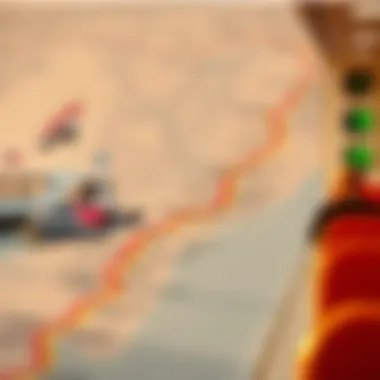
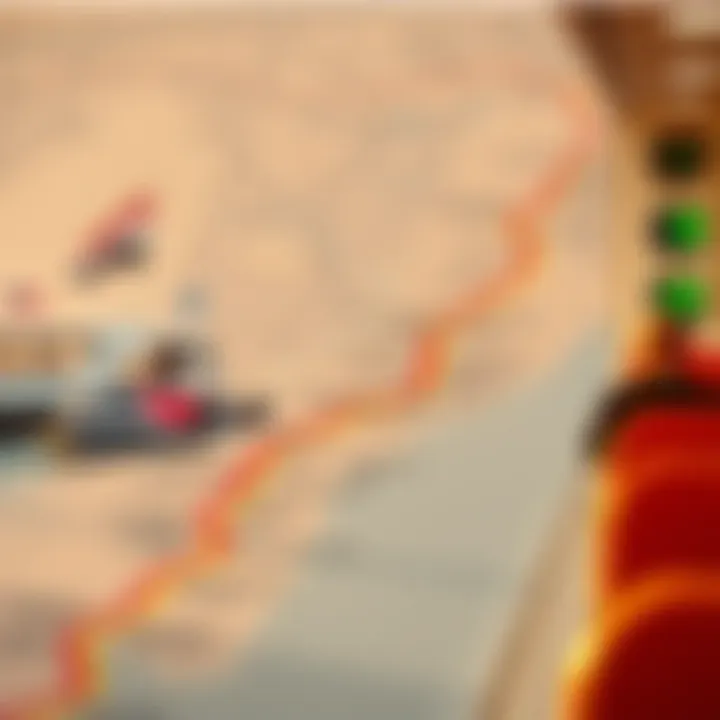
- Flexibility: Passengers can choose their destinations, tailoring the journey according to their needs.
- Privacy: Ideal for business meetings or private excursions, with room for up to 7 passengers.
- Service: Taxis are operated by trained captains ensuring safe navigation through the waterways.
For those seeking efficiency and comfort, Water Taxis are a prime choice, merging modernity with the scenic charm of Dubai's waterways.
In summary, the variety of ferry services provided by Dubai's RTA caters to numerous travel preferences, enhancing the overall landscape of urban mobility within the emirate.
Ferry Timings Overview
Understanding the ferry timings is crucial for making the most out of Dubai's RTA ferry system. A well-planned schedule ensures that commuters and tourists alike can navigate the waters of Dubai efficiently. Timings dictate not only the frequency of ferries but also influence the overall travel experience. Knowing when the ferries operate allows passengers to plan their journeys effectively, avoiding long waits and ensuring that they can reach their destinations on time.
Importance of Ferry Timings
- Efficiency in Planning: Whether it’s a daily commute or a weekend outing, having up-to-date information about ferry schedules helps in better planning. Commuters can align their travel with other transport options, thus enhancing overall mobility in the city.
- Flexibility: With different schedules for weekdays and weekends, understanding the timings allows passengers to select their travel time more freely. For instance, a business professional may choose an early morning ferry on weekdays, while a family might prefer later departures during weekends.
- Awareness of Special Circumstances: Holidays and special events can affect ferry timings significantly. By staying informed, travelers can adjust their plans accordingly, minimizing inconvenience and ensuring a smooth travel experience.
Timings can vary based on the day of the week, types of services available, and various other local events. Therefore, it's essential to stay updated on what’s in store, guaranteeing an experience with fewer surprises.
Weekday Schedules
The weekday schedules for RTA ferries generally follow a consistent pattern, aimed at accommodating the busy lives of locals and tourists. Most services kick off early in the morning, making it convenient for individuals heading to work.
- Early Morning Departures: Ferries often start operating around 6:00 AM, which is ideal for early risers.
- Peak Hours: From about 7:00 AM to 9:00 AM, the ferries tend to be more frequent to cater to the workforce traveling to key commercial areas.
- Midday and Afternoon: During midday, schedules may reduce slightly but are usually still manageable for tourists and casual riders.
- Evening Return and Late Services: After work hours, ferries operate until about 11:00 PM, ensuring that individuals can return home after a busy day.
This structure provides a good balance, but travelers should keep an eye on possible changes, especially during peak travel seasons.
Weekend Schedules
On weekends, the vibe shifts, and ferry schedules adapt accordingly to accommodate leisure travelers. Ferries usually start around 10:00 AM and continue to run at redeveloped frequencies to meet demand.
- Leisurely Start: Unlike weekdays, people can take their time, with ferries starting later in the morning.
- Increased Frequency: With more people looking to explore, ferries may operate more frequently during the day, especially around popular tourist destinations.
- Evening Hours: Late-night operations may continue, allowing for nighttime activities on the water, possibly aligning with events in the city.
It's worthwhile to check the exact timings as they can shift based on the season or special events.
Public Holidays and Special Events
Public holidays in Dubai can bring about significant changes to ferry schedules. On such occasions, it is essential to be informed to ensure a smooth journey.
- Holiday Timing Adjustments: RTA usually announces specific schedules on their official platforms closer to the date of the holiday. Riders should check for any alterations to normal service.
- Special Events Influence: Major events, such as festivals or celebrations, can lead to extended operational hours or increased frequency, particularly for routes serving event locations.
- Crowd Management: On holidays, ferries may attract larger crowds, and travelers should plan accordingly, arriving early to secure their spots.
Staying updated on these changes can make the difference between chaos and a seamless travel experience.
Overall, understanding the ferry timings provides the framework necessary for a well-executed travel plan within the vibrant context of Dubai’s waterways.
Key Ferry Routes
The ferry routes of Dubai's RTA system serve as crucial arteries that facilitate travel across the city's scenic waterways. These routes not only connect communities but also play a significant role in enhancing urban mobility. Given Dubai's sprawling layout, using water transportation can often be more efficient than roads, especially during peak traffic hours. Understanding these key ferry routes can help commuters and tourists alike maximize their time and engage more deeply with the city's vibrant coastal lifestyle.
Bur Dubai to Deira
One of the most popular routes is the ferry service from Bur Dubai to Deira. This route is frequented by both locals and visitors, enabling easy access to some of Dubai's cultural landmarks. The route usually takes around 10 to 15 minutes, depending on the weather conditions and passenger volume.
This ferry ride offers stunning views of the skyline, with the allure of the Burj Khalifa and the historic buildings along the Dubai Creek. As you glide across the waters, it’s not just about the destination; it’s about the journey. For many, the experience is akin to skating on a silken ribbon of water, cutting through the vibrant tapestry of life on either side.
- Benefits:
- Short travel time enhances convenience.
- Scenic views make the journey enjoyable.
- Direct access to major shopping and dining areas in Deira.
Travelers may consider this ferry as a viable alternative to the bus or metro routes, particularly when exploring areas rich in history such as the Dubai Aquarium or the Gold Souk. It effectively cuts through the congestion of road traffic, making it a favorite for hassle-free travel.
Jaddaf to Marina
The Jaddaf to Marina route showcases another facet of the ferry system, promoting not just practicality but leisure as well. This route is slightly longer, providing passengers with a delightful journey across the city's waterways. In approximately 30 minutes, one can transition from the traditional allure of Jaddaf to the contemporary buzz of Marina, reflecting Dubai's fusion of the old and the new.
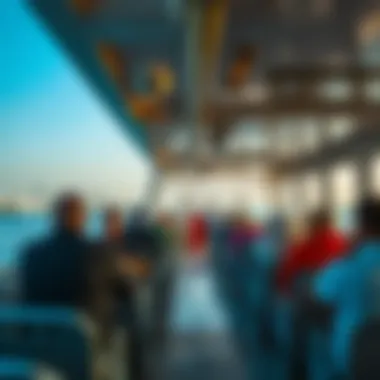
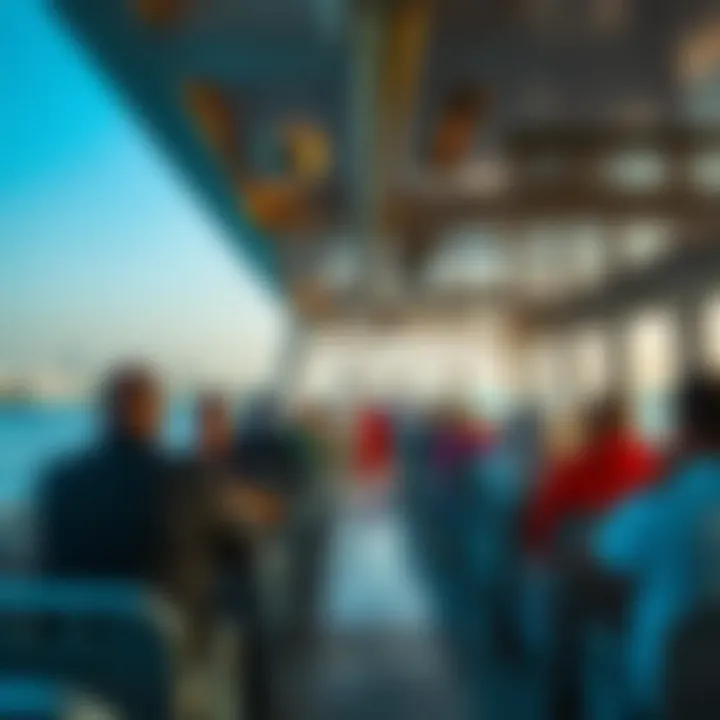
What makes this route particularly captivating is the opportunity to observe the contrast between historic districts and modern developments. Travelers aboard the ferry will witness the skyline shift dramatically from the modest yet charming buildings of Jaddaf to the stunning architectural marvels populating the Marina district.
- Considerations:
- Ideal for leisurely sightseeing.
- Connects culturally rich areas with modern entertainment hubs.
- Increased travel time so travelers can plan accordingly.
Incorporating this ferry route into a day out can lead to an enriched travel experience. People can combine dining, leisure activities, and sightseeing without a hitch, showcasing the seamless integration of this water transport into Dubai's city life.
Additional Routes
In addition to the prominent Bur Dubai to Deira and Jaddaf to Marina routes, the RTA operates several other important ferry routes that facilitate access across various parts of Dubai. Some noteworthy mentions include:
- Al Qouz to Al Safa: A lesser-known but essential route that connects commercial districts, making it accessible for business travelers.
- Dubai Festival City to the Creek: Targets tourists visiting major shopping and entertainment venues.
- Palm Jumeirah Routes: Offers breathtaking views of the Dubai coastline and is favored by tourists.
These additional routes confirm that the ferry system is not just about convenience. They also help foster community ties and boost local tourism. Whether one is contemplating a casual outing or daily commuting, Dubai's ferry services provide flexibility and productivity, making it a travel option worth exploring for anyone navigating through this dynamic city.
Ticketing and Pricing Structure
An efficient ticketing and pricing structure is vital for the overall functionality of the Dubai RTA ferry system. This facet paves the way for seamless travel experiences, making it essential for individuals, whether they’re daily commuters or occasional riders. The way tickets are priced and sold not only influences footfall but also shapes the way people reconsider their travel options, merging convenience with budget-friendliness.
Fare Types
When it comes to fares, the Dubai RTA ferry system offers a range of options tailored to suit various passenger needs. Unlike many transport systems that may rely on a single ticketing approach, Dubai’s ferries differentiate themselves through several fare categories:
- Standard Ticket: This is the most common fare, useful for one-off journeys. Effective for tourists or individuals who might consider a ferry ride as part of a day out.
- Monthly Pass: For those who use the ferries regularly, this is a cost-effective choice. It allows for unlimited rides within a given period, catering well to the daily commuter who seeks savings.
- Tourist Pass: This specialized fare caters to travelers who are exploring the city and are likely to hop on and off at various stops along their routes.
It's important to be aware that fares can vary depending on the specific route taken, with longer rides attracting higher costs. Monitoring fare updates regularly can help avid users of the service budget their trips accordingly.
Discounts and Promotions
The RTA often rolls out various discounts and promotions to incentivize more passengers to utilize the ferry service. These offers can include seasonal discounts or special fares during public holidays, which emphasize the RTA’s commitment to boosting public transportation usage. Here are a few notable promotions:
- Family Discounts: Aimed at encouraging family outings, travelers can avail reduced rates when purchasing multiple tickets at once.
- Student and Senior Citizen Discounts: Lowered fares are generally available for students and the elderly, making the ferry accessible for all age groups.
- Promotions Linked to Events: If a major event is happening in or around Dubai, it’s common for the RTA to introduce temporary discounts. Always check the RTA’s official channels for up-to-date information on current promotions.
Payment Methods
Convenience extends to how tickets can be purchased, with multiple payment methods to accommodate the diverse range of ferry users. Riders have options to ease their journey:
- Nol Card: This smart travel card is not just valid for the metro and buses but also applies to ferry journeys. Users can load money onto their Nol card, making it simpler to hop on the ferry without needing to carry cash.
- Mobile Payment: Increasingly, contactless mobile payment methods are accepted, which adds another level of convenience.
- Onboard Cash Payments: For those who prefer traditional methods, cash can often still be used to purchase tickets directly from ferry staff, though it’s prudent to have the exact amount ready given that change may not always be available.
The variety in ticketing options and payment methods exemplifies the RTA's dedication to enhancing the travel experience. As the ferry system continues to evolve, remaining informed about any updates can only serve to improve one’s travel strategy.
Safety and Accessibility Measures
Safety and accessibility measures are crucial aspects of the Dubai RTA ferry system. These regulations and facilities are designed not only to protect passengers but also to ensure that everyone, regardless of their physical abilities, can enjoy the ferry services. It’s essential to recognize how these measures enhance the overall travel experience while navigating the beautiful waterways of Dubai.
Safety Regulations
The safety of passengers is paramount in Dubai's RTA ferry operations. Regulatory compliance is enforced through strict guidelines to minimize risk and enhance passenger well-being. Here are some key elements of safety regulations:
- Life Jackets and Safety Equipment: Each ferry is equipped with life jackets, fire extinguishers, and first aid kits. Conducting regular checks ensures that this equipment is always in excellent condition.
- Crew Training: Personnel receive comprehensive training in safety protocols and emergency situations. In a crisis, having well-prepared crew members can make all the difference.
- Passenger Guidelines: Clear instructions are provided to passengers regarding their conduct aboard the ferries to maintain order and safety. Regulations discourage overcrowding, enforce proper seating arrangements, and highlight safety measures during boarding and alighting.
The RTA also collaborates with local authorities to conduct safety drills. These exercises involve the crew and emergency services, fostering a solid response mechanism for any potential emergencies.
"Safety is not just a priority; it's the foundation of transportation that we build on, ensuring every journey is as secure as it is enjoyable."
Facilities for Differently-Abled Passengers
Accessibility is another cornerstone of the Dubai RTA ferry service, reflecting a commitment to inclusivity. The ferries are designed with several features to accommodate passengers with disabilities, ensuring they can travel without limitations. Important aspects include:
- Ramp Access: Ferries are equipped with ramps for easy boarding and disembarking. This feature makes it convenient for wheelchair users or those with mobility impairments to access the vessels.
- Dedicated Spaces: Inside the ferry, specific areas are reserved for differently-abled passengers, ensuring they can travel comfortably without being cramped by the general crowd.
- Assistance Services: The RTA provides staff on hand to assist individuals needing extra help. From guiding passengers to securing mobility aids, these services bridge the gap to ensure all can enjoy the ferry experience.
- Informative Signage: Clear visual and auditory information is provided to help differently-abled passengers navigate smoothly. This includes announcements and signs highlighting important safety measures and routes.


Overall, safety and accessibility measures within the Dubai ferry services are thoughtfully designed to foster an environment where passengers can travel with peace of mind and satisfaction. The combination of stringent regulations and specialized facilities makes the ferry system not only functional but exemplary in terms of inclusivity. This approach not only enriches the daily commute for many residents but also enhances the tourism experience for visitors, showcasing Dubai's commitment to innovation and excellence.
Impact of Ferry Services on Urban Mobility
The integration of ferry services into Dubai's transport ecosystem represents a crucial step in addressing the challenges of urban mobility. As the city grows and its population thrives, traffic congestion becomes a pressing concern. The RTA ferry services not only provide a picturesque alternative for commuting but also significantly contribute to reducing the number of vehicles on the roads. This shift in travel habits can ease the burden on road networks and lead to a more sustainable urban environment.
Integration with Other Transport Modes
For ferry services to be an effective component of urban mobility, they must link seamlessly with other modes of transportation. Dubai has made significant strides in integrating its ferries with buses, metro, and tram systems. Passengers can easily transfer from a ferry to the metro station, allowing for smooth travel across the city. This intermodal connectivity ensures that ferries do not operate in isolation but as part of a broader transport network
- Bus Connections: Several bus routes connect key ferry terminals. For instance, reaching Bur Dubai or Deira from the ferry stops is straightforward—passengers can hop on an RTA bus that runs regularly between these points.
- Metro Access: The direct access to metro stations, especially in the downtown area, is a boon for commuters. It allows for efficient transfers without the hassle of long waits or complicated pathways.
- Tram Services: In areas like Dubai Marina, ferry services connect well with the tram, providing scenic routes for leisure travelers and convenience for daily commuters.
This web of connectivity facilitates diverse commuting choices while enhancing the overall travel experience. As a result, passengers have greater flexibility when planning their trips, whether for work or leisure.
Travel Time Efficiency
Leveraging ferry services not only adds to the aesthetic of commuting in Dubai but improves travel time efficiency significantly. On several routes, the ferry offers a more direct path across the city, especially across the waterways that can often bypass congested streets. Both residents and tourists benefit from this time-saving aspect.
In a bustling city like Dubai, where traffic can back up faster than a cheetah on the hunt, the ferry's ability to transport people over water can shave off valuable minutes.
- Shorter Distances: For example, the journey from Bur Dubai to Deira takes about 10 minutes on the ferry, whereas a road trip could take much longer depending on traffic conditions.
- Reliable Schedules: The RTA maintains a consistent and reliable schedule for its ferries, which users can rely on. Unlike other transport modes susceptible to traffic delays, ferries often stick to their timings, making them a trustworthy option for punctuality.
- Real-time Updates: Passengers can check ferry timings through the RTA app or website. The convenience of real-time updates assures passengers of their travel plans and aids in better time management.
By choosing to use the ferry services, commuters can effectively minimize their travel time, which is a key factor when deciding how best to navigate an urban environment. As ferry services continue to expand and improve, their role in shaping the future of urban transit in Dubai can only be expected to grow.
Future Developments in Ferry Services
As Dubai continues to evolve as a leading global city, the development of its ferry services remains a critical aspect of enhancing urban mobility. These services are not only essential for daily commuters but also contribute significantly to the city’s tourism sector. Understanding the future developments in ferry services paves the way for improved connectivity across the waterways of Dubai. It places emphasis on the strategic planning crucial to meeting the increasing demand from both residents and visitors. Furthermore, innovative approaches to ferry operations can encourage investment and sustainable practices in urban transport.
Upcoming Routes
Expanding the ferry network is crucial for developing seamless connectivity between key areas in Dubai. One of the notable upcoming routes is the extension of services to Al Mamzar Beach Park, which will attract more local and international tourists. This route will likely be designed to accommodate wave and beach-going crowds, bringing ferry transport closer to leisure points without adding pressure to existing road networks.
In addition to this, there's a potential ferry route set to link the bustling Dubai Creek area with the new developments along the Dubai Marina. This would not only reduce travel times but also provide stunning views of waterfront landmarks, thus enriching the passenger experience.
- Potential routes to watch out for include:
- Al Mamzar Beach Park to Bur Dubai
- Creek Harbour to Dubai Marina
- Jumeirah Beach Residence to Bluewaters Island
Such investments in ferry routes signify the RTA's commitment to ensure essential transport links while promoting the scenic beauty of Dubai’s coasts. By diversifying available routes, ferry services can become a go-to option for reliable and pleasant travel in the city.
Technological Innovations
The future of ferry services in Dubai is also intertwined with technological advancements. As the RTA keeps pace with global trends, the implementation of smart ticketing systems will likely be on the horizon. This technology enables easy payment via mobile applications or contactless cards, simplifying the process of boarding ferries while ensuring safe and efficient travel.
Moreover, there’s discussion around integrating updated navigation systems that utilize real-time data for managing schedules and routes. By employing artificial intelligence, the ferry service can anticipate demand spikes and adjust schedules accordingly, reducing wait times and enhancing overall efficiency.
Some additional technological innovations to expect include:
- Eco-friendly ferry designs that minimize environmental impact.
- Enhanced onboard experiences through Wi-Fi and digital information displays.
- Automated systems for smoother operations and improved safety protocols.
As Dubai’s RTA embraces these advancements, it not only aims to elevate the user experience but also to promote a sustainable transport ecosystem. Investing in these technologies shows a forward-thinking attitude, catering to the demands of a modern metropolitan lifestyle while preserving the natural beauty of its waterways.
Ending
The discussion around ferry services in Dubai is more than just about crossing water. It intertwines with the fabric of urban mobility, economic growth, and environmental sustainability. Understanding the ferry timings is critical for both residents and tourists, ensuring they can seamlessly integrate this mode of transport into their daily routines or vacation plans. By knowing when and where ferries operate, travelers can maximize their time in the city while enjoying its stunning waterfront views.
Summary of Key Points
To summarize, here's a breakdown of the essential insights discussed in this article:
- Ferry Types: Dubai's RTA operates several types of vessels, including Waterbuses, Abras, and Water Taxis, each catering to different travel needs and experiences.
- Ferry Timings: Comprehending both the weekday and weekend ferry schedules provides essential guidance for planning.
- Routes: Key ferry routes connect various vital areas, enhancing access to different parts of the city while reducing road traffic congestion.
- Ticketing Structure: Understanding prices, fare types, and available discounts can lead to more economical travel choices.
- Safety and Accessibility: RTA's commitment to passenger safety and the inclusion of facilities for differently-abled travelers speak volumes about their operational standards.
- Future Developments: Ongoing enhancements and innovations hint at a promising direction for ferry services within Dubai.
These points reflect the intricate layers of the ferry system and emphasize its role within the larger narrative of transportation in the UAE's bustling metropolis.
Final Thoughts on Utilization
In closing, the utilization of ferry services in Dubai should be regarded as an opportunity rather than merely a transportation option. As the city continues to grow, embracing this water-based travel means tapping into an efficient, scenic, and often less congested method of navigating urban landscapes. For investors, realtors, and residents, understanding these aspects can lead to informed decisions regarding real estate value propositions, tourist experiences, and lifestyle considerations.
Encouraging the use of ferries can also have broader benefits, such as alleviating traffic and promoting sustainable transport solutions. The key takeaway is clear: leveraging the Dubai RTA ferry system enhances not just commuting but also enriches the overall experience of living and working in this vibrant city. Whether you're a long-term resident or just visiting, stepping onto a ferry can elevate your perspective, allowing you to appreciate Dubai from its most captivating vantage point.

